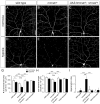The role of autophagy in Nmnat-mediated protection against hypoxia-induced dendrite degeneration
- PMID: 23159780
- PMCID: PMC3540192
- DOI: 10.1016/j.mcn.2012.11.008
The role of autophagy in Nmnat-mediated protection against hypoxia-induced dendrite degeneration
Abstract
The selective degeneration of dendrites precedes neuronal cell death in hypoxia-ischemia (HI) and is a neuropathological hallmark of stroke. While it is clear that a number of different molecular pathways likely contribute to neuronal cell death in HI, the mechanisms that govern HI-induced dendrite degeneration are largely unknown. Here, we show that the NAD synthase nicotinamide mononucleotide adenylyltransferase (Nmnat) functions endogenously to protect Drosophila class IV dendritic arborization (da) sensory neurons against hypoxia-induced dendritic damage. Whereas dendrites of wild-type class IV neurons are largely resistant to morphological changes during prolonged periods of hypoxia (<1.0% O(2)), class IV neurons of nmnat heterozygous mutants exhibit significant dendrite loss and extensive fragmentation of the dendritic arbor under the same hypoxic conditions. Although basal levels of autophagy are required for neuronal survival, we demonstrate that autophagy is dispensable for maintaining the dendritic integrity of class IV neurons. However, we find that genetically blocking autophagy can suppress hypoxia-induced dendrite degeneration of nmnat heterozygous mutants in a cell-autonomous manner, suggestive of a self-destructive role for autophagy in this context. We further show that inducing autophagy by overexpression of the autophagy-specific kinase Atg1 is sufficient to cause dendrite degeneration of class IV neurons under hypoxia and that overexpression of Nmnat fails to protect class IV dendrites from the effects of Atg1 overexpression. Our studies reveal an essential neuroprotective role for endogenous Nmnat in hypoxia and demonstrate that Nmnat functions upstream of autophagy to mitigate the damage incurred by dendrites in neurons under hypoxic stress.
Copyright © 2012 Elsevier Inc. All rights reserved.
Figures








Similar articles
-
Nmnat exerts neuroprotective effects in dendrites and axons.Mol Cell Neurosci. 2011 Sep;48(1):1-8. doi: 10.1016/j.mcn.2011.05.002. Epub 2011 May 9. Mol Cell Neurosci. 2011. PMID: 21596138 Free PMC article.
-
Drosophila NMNAT maintains neural integrity independent of its NAD synthesis activity.PLoS Biol. 2006 Nov;4(12):e416. doi: 10.1371/journal.pbio.0040416. PLoS Biol. 2006. PMID: 17132048 Free PMC article.
-
Phagocytosis and self-destruction break down dendrites of Drosophila sensory neurons at distinct steps of Wallerian degeneration.Proc Natl Acad Sci U S A. 2022 Jan 25;119(4):e2111818119. doi: 10.1073/pnas.2111818119. Proc Natl Acad Sci U S A. 2022. PMID: 35058357 Free PMC article.
-
Why is NMNAT Protective against Neuronal Cell Death and Axon Degeneration, but Inhibitory of Axon Regeneration?Cells. 2019 Mar 21;8(3):267. doi: 10.3390/cells8030267. Cells. 2019. PMID: 30901919 Free PMC article. Review.
-
Autophagy in axonal and dendritic degeneration.Trends Neurosci. 2013 Jul;36(7):418-28. doi: 10.1016/j.tins.2013.04.001. Epub 2013 Apr 30. Trends Neurosci. 2013. PMID: 23639383 Free PMC article. Review.
Cited by
-
Neuronal autophagy and axon degeneration.Cell Mol Life Sci. 2018 Jul;75(13):2389-2406. doi: 10.1007/s00018-018-2812-1. Epub 2018 Apr 19. Cell Mol Life Sci. 2018. PMID: 29675785 Free PMC article. Review.
-
Basal autophagy is required for promoting dendritic terminal branching in Drosophila sensory neurons.PLoS One. 2018 Nov 5;13(11):e0206743. doi: 10.1371/journal.pone.0206743. eCollection 2018. PLoS One. 2018. PMID: 30395636 Free PMC article.
-
Predicting early Alzheimer's with blood biomarkers and clinical features.Sci Rep. 2024 Mar 13;14(1):6039. doi: 10.1038/s41598-024-56489-1. Sci Rep. 2024. PMID: 38472245 Free PMC article.
-
NMNAT3 is protective against the effects of neonatal cerebral hypoxia-ischemia.Ann Clin Transl Neurol. 2017 Aug 30;4(10):722-738. doi: 10.1002/acn3.450. eCollection 2017 Oct. Ann Clin Transl Neurol. 2017. PMID: 29046881 Free PMC article.
-
Hypoxic Preconditioning Protects SH-SY5Y Cell against Oxidative Stress through Activation of Autophagy.Cell Transplant. 2018 Dec;27(12):1753-1762. doi: 10.1177/0963689718760486. Epub 2018 Jun 5. Cell Transplant. 2018. PMID: 29871517 Free PMC article.
References
-
- Adhami F, Liao G, Morozov YM, Schloemer A, Schmithorst VJ, Lorenz JN, Dunn RS, Vorhees CV, Wills-Karp M, Degen JL, Davis RJ, Mizushima N, Rakic P, Dardzinski BJ, Holland SK, Sharp FR, Kuan CY. Cerebral ischemia-hypoxia induces intravascular coagulation and autophagy. Am J Pathol. 2006;169:566–583. - PMC - PubMed
Publication types
MeSH terms
Substances
Grants and funding
LinkOut - more resources
Full Text Sources
Other Literature Sources
Molecular Biology Databases

